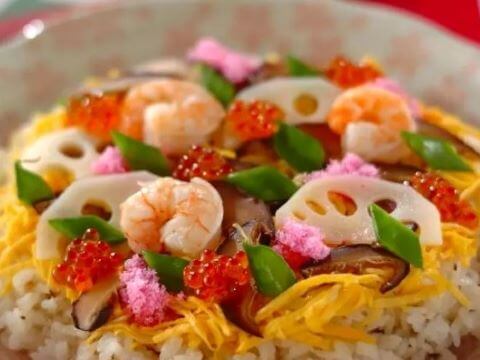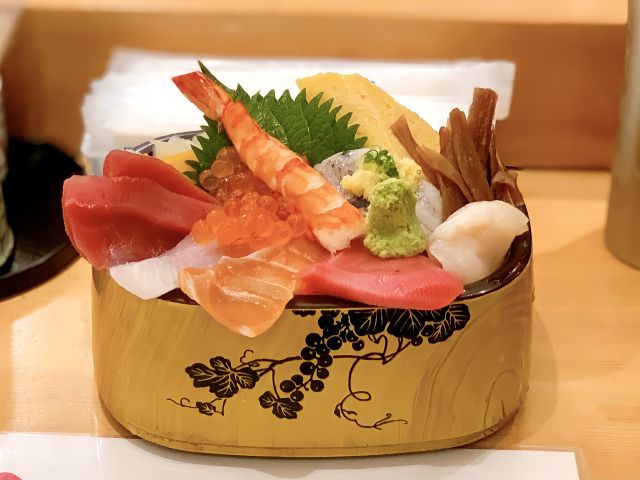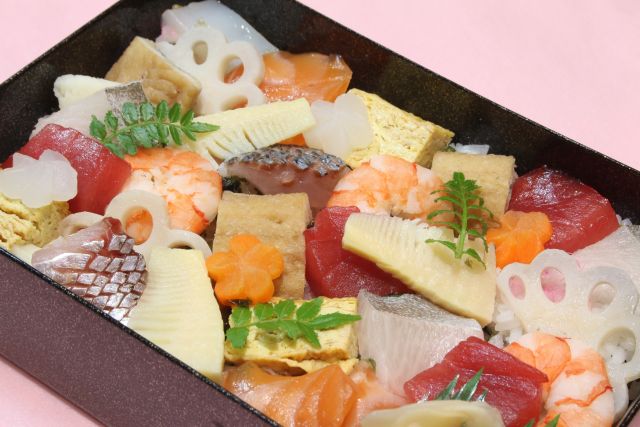
Recently, I came across an image on social media of Barachirashizushi made by an American sushi chef. I was surprised to see that Barachirashizushi, a dish traditionally made only by a few sushi restaurants that uphold the Edomae-style, had been created by a sushi chef outside Japan. However, it was labeled as Chirashizushi, which I found disappointing, so I will explain the difference.
The term “chirashizushi” (or “chirashi sushi”) originates from the act of scattering various ingredients over or within vinegared rice and is sometimes referred to simply as “chirashi.” Generally, “Gomokuzushi” refers to vinegared rice mixed with ingredients, while “chirashizushi” refers to vinegared rice topped with arranged ingredients. However, these terms are not strictly distinguished. The names may vary depending on the region (e.g., Kanto or Kansai) and generation.
First, let’s explore the origin of chirashizushi. The term “barazushi” appears here, but it is different from barachirashizushi.
Barazushi, a type of sushi from Okayama, is said to date back to the early Edo period. At that time, the feudal lord of Okayama Domain, Ikeda Mitsumasa (1609–1682), promoted frugality and simplicity. He issued the “One Soup, One Side Dish Edict,” which restricted side dishes to one item other than soup.
They finely chopped ingredients such as simmered shiitake mushrooms, kanpyo (dried gourd strips), and carrots and secretly mixed them into the rice. According to one story, sushi ingredients were placed at the bottom of a box and covered with seasoned rice to disguise them as a simple meal. The box was then flipped over just before serving.
As “Barazushi” spread throughout Japan, a style of scattering the ingredients on top of the vinegared rice rather than mixing them in was developed, and this became known as “Chirashizushi.”
Now, let’s look at the difference between chirashizushi and barachirashizushi, focusing on the names used in sushi restaurants in Tokyo.

In Tokyo sushi, specifically Edomae sushi, Chirasushizushi refers to a dish where sushi toppings used for Nigiri sushi are arranged on top of vinegared rice (also known as Namachirashi, Fukiyosechirashi, or Edomaechirashi). However, in regions outside the Tokyo area, Chirashizushi generally refers to a dish where seasoned ingredients are mixed into vinegared rice and decorated with shredded omelette and seaweed (also known as Gomokuzushi or Barazsuhi). This is just my personal opinion, but I think that even in Tokyo, the latter is called chirashizushi.
Dishes made with plain white rice rather than vinegared rice are generally called seafood bowls. Sushi restaurants do not serve bowls of plain white rice (they cannot), but some restaurants call dishes made with vinegared rice seafood bowls. In my personal opinion, most seafood bowls served outside of sushi restaurants are made with plain white rice.

Additionally, a dish with randomly arranged sushi toppings on vinegared rice is called “barachirashizushi.” Some traditional sushi restaurants in Tokyo offer two types: chirashizushi, which is primarily served in-store, and barachirashizushi, which excludes toppings that are not suitable for takeout and can be taken home.
Incidentally, chirashizushi made with sushi ingredients is not typically prepared in Kanto-style households. More precisely, it may include decorative toppings such as ikura (salmon roe), tobiko (flying fish roe), and steamed shrimp; however, the standard ingredients are dried shiitake mushrooms, lotus root, carrots, snow peas, and shredded omelet.